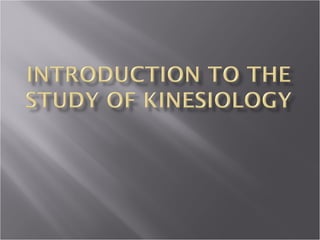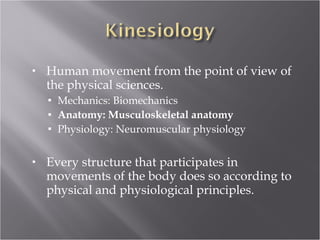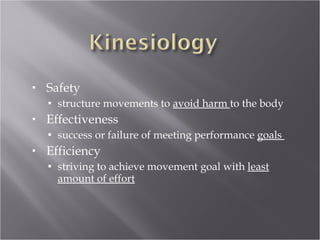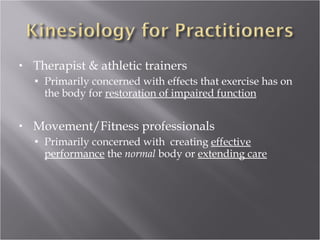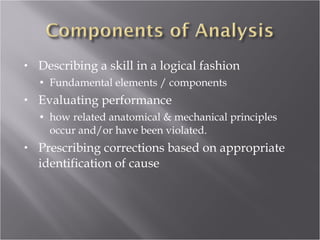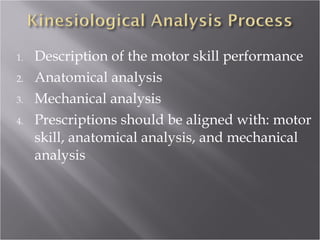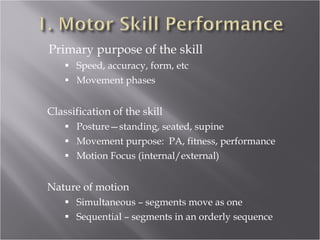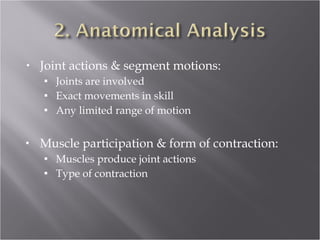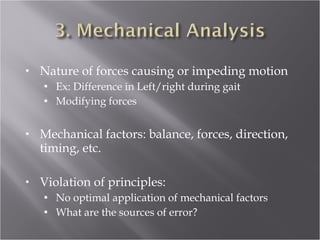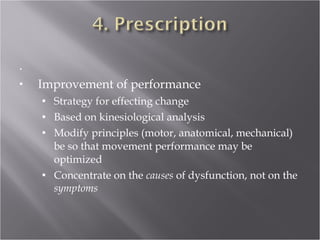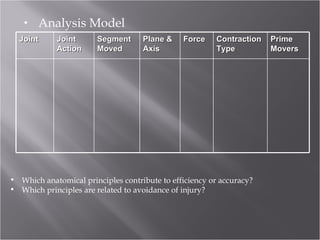Kinesiology intro 1
- 2. Human movement from the point of view of the physical sciences. Mechanics: Biomechanics Anatomy: Musculoskeletal anatomy Physiology: Neuromuscular physiology Every structure that participates in movements of the body does so according to physical and physiological principles.
- 3. Safety structure movements to avoid harm to the body Effectiveness success or failure of meeting performance goals Efficiency striving to achieve movement goal with least amount of effort
- 4. Therapist & athletic trainers Primarily concerned with effects that exercise has on the body for restoration of impaired function Movement/Fitness professionals Primarily concerned with creating effective performance the normal body or extending care
- 5. Describing a skill in a logical fashion Fundamental elements / components Evaluating performance how related anatomical & mechanical principles occur and/or have been violated. Prescribing corrections based on appropriate identification of cause
- 6. Description of the motor skill performance Anatomical analysis Mechanical analysis Prescriptions should be aligned with: motor skill, anatomical analysis, and mechanical analysis
- 7. Primary purpose of the skill Speed, accuracy, form, etc Movement phases Classification of the skill Posture—standing, seated, supine Movement purpose: PA, fitness, performance Motion Focus (internal /external) Nature of motion Simultaneous – segments move as one Sequential – segments in an orderly sequence
- 8. Joint actions & segment motions: Joints are involved Exact movements in skill Any limited range of motion Muscle participation & form of contraction: Muscles produce joint actions Type of contraction
- 9. Nature of forces causing or impeding motion Ex: Difference in Left/right during gait Modifying forces Mechanical factors: balance, forces, direction, timing, etc. Violation of principles: No optimal application of mechanical factors What are the sources of error?
- 10. . Improvement of performance Strategy for effecting change Based on kinesiological analysis Modify principles (motor, anatomical, mechanical) be so that movement performance may be optimized Concentrate on the causes of dysfunction, not on the symptoms
- 11. Analysis Model Which anatomical principles contribute to efficiency or accuracy? Which principles are related to avoidance of injury? Joint Joint Action Segment Moved Plane & Axis Force Contraction Type Prime Movers
Editor's Notes
- #3: Anatomical components that translate to mechanical actions
- #9: which joints are involved are any of the joints used to the limit of their RoM what muscles neuromuscular mechanisms which anatomical principles contribute to maximal efficiency and accuracy in the performance of the motor skill? Which principles are directly
